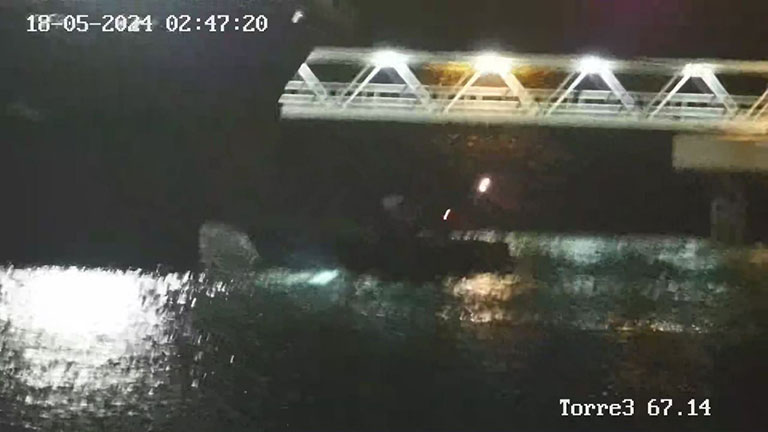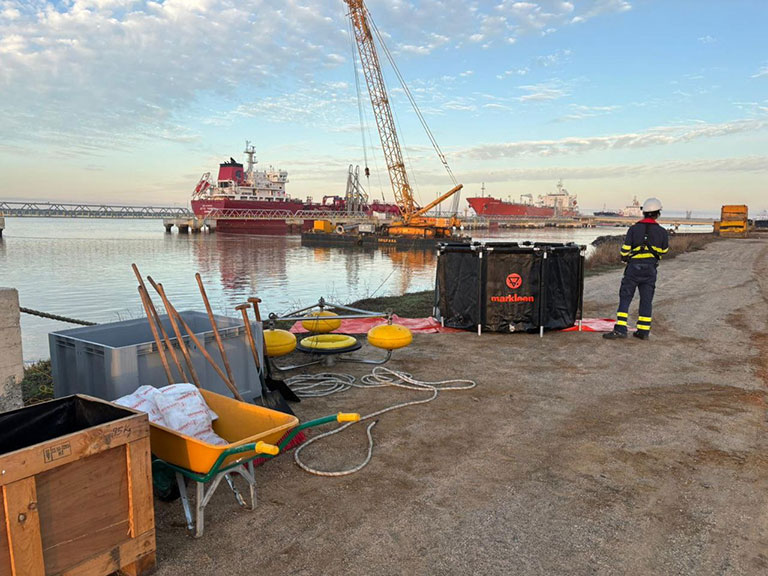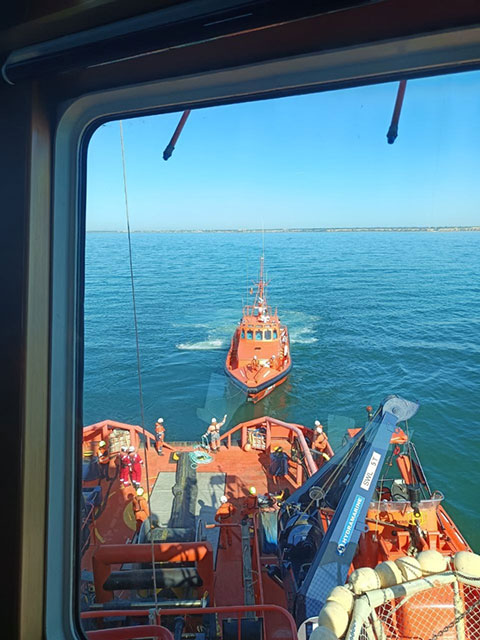Evolution of annual accident frequency rate (FR) (S_14)
IF = (total number of accidents with sick leave / number of hours worked) x 106
| 2022 | 2023 | 2024 | |
|---|---|---|---|
| No. of accidents with sick leave per million hours worked | 5.97 | 17.56 | 2.84 |
Evolution of the annual accident severity rate (SR) (S_15)
IG = (number of days lost due to accidents / number of hours worked) x 103
| 2022 | 2023 | 2024 | |
|---|---|---|---|
| No. of days lost per 1,000 hours worked | 0.17 | 0.09 | 0.04 |
Effort made in occupational risk prevention training (S_17)
| 2024 | |
|---|---|
| Total number of training hours | 102 |
| Total no. of employees (annual average workforce) | 214 |
| Average number of hours per worker | 0.48 |
Security and safety exercises and simulations (S_18)
The following security drills and exercises were carried out in 2024:
| Protection | |
| 17/05/2024 | Upgrading of the Port's protection level and an IP assault |
| 06/08/2024 | Threat of explosives being placed in the I.P. Change of Protection Level |
| 18/09/2024 | Drone in the vicinity of the ENAGAS port facility |
| 26/11/2024 | Management of external drone threat at FERTIBERIA facilities |
| 23/12/2024 | Verification of the state of operation of the access control system of the Port Authority's facilities |
| Self-protection | |
| 17/01/2024 | Visits to the Port Services Control Centre to inform the members of the SEIS group about the functions and tasks carried out by the Operators and Team Leaders/Railway Traffic Managers, to inform them about the applications they work with, as well as the different plans that are activated in the Port of Huelva and, within these, how emergencies are managed and how both operational and communications procedures are carried out |
| 07/02/2024 | |
| 21/02/2024 | |
| 06/03/2024 | |
| 20/03/2024 | |
| 10/04/2024 | Simulations of a rear-end collision between a passenger car and a lorry with P.M. with valve breakage and product leakage |
| 24/04/2024 | |
| 08/05/2024 | |
| 22/05/2024 | |
| 05/06/2024 | |
| 18/09/2024 | Exercises with rotary turbopumps, to see their performance, usefulness and manoeuvrability |
| 25/09/2024 | |
| 02/10/2024 | |
| 13/11/2024 | |
| 20/11/2024 | |
| Maritime hinterland plan | |
| 24/04/2024 | PIM IMPALA activation drill |
| 20/06/2024 | ENAGAS MIP activation drill |
| 22/10/2024 | PIM-PMN activation exercise DECAL/APH/SASEMAR/CM |
| 11/11/2024 | ENAGAS MIP activation drill |
| 11/12/2024 | PIM ATLANTIC COPPER PIM activation drill |


With regard to the annual Port Security Plan exercise, the following objectives were set:
- Training in the Plan’s procedures, and in particular the procedure: Q. SECURITY INCIDENT RESPONSE PROCEDURES/STANDARDS FOR ACTION – T2
- Co-ordination with the SSCDF
- Training in level change procedures.
During the week of 13 to 18 May, the Army’s Special Operations Command (MOE) conducted training exercises in the area surrounding the Port of Huelva.
One of the exercises they had planned consisted of an assault on a facility and another was the sabotage of a ship moored at a port facility, accessing it by diving with a closed circuit from the right bank of the estuary.
In order to implement our Port Protection Plan, the role we assumed was the opposite; we pretended that the MOE combat patrols were our threat.
The development was broadly in line with the following timetable:
- The Port Control Services Centre (CPCS) receives notification from the Permanent Information and Coordination Centre (CEPIC) ordering the Port’s security level to be raised from 1 to 2 (the Port Security Officer PPO simulating the CEPIC).
- The CPCS operator immediately informs the OPP by telephone.
- OPP instructs the CPCS to take the following actions:
- Inform COS of the Guardia Civil via telephone.
- Immediately adopt the measures set out in the port security plan, the CPCS will step up CCTV surveillance (we will not set out the procedures for access control as this is not the subject of the exercise).
- Acknowledgement of receipt to CEPIC (Simulated, to be forwarded to the OPP).
- OPP reports by telephone to the Chairperson of the PCC (Director of the HPA), then to the PCC members.
- The CPCS operators were not given any indication of the areas and scenarios to be considered in order to simulate as closely as possible the reality of protection level 2 surveillance.
- It should be noted that we could not identify the attacker; we only detected the safety boats for the divers and control of the navigation of smaller boats in the channel.
Within the scope of the Self-Protection Plan, in addition to familiarisation with the environment and training in the use of equipment, five exercises were carried out simulating traffic accidents involving PM, in these cases a collision between a car and a tanker loaded with ammonia, resulting in the breakage of a valve and the leakage of the product.
With these exercises, we have pursued the following objectives:
- To familiarise the Intervention Group with accidents involving vehicles transporting Dangerous Goods.
- To familiarise the Order Group, the port police, with its operating procedures.
- Train communication procedures between the members of the Self-Protection Plan.
- Test what has been learned in previous simulations.




Deploying the following teams:
- URQ (Chemical Risk Unit)
- 1 BUP (Heavy Urban Pump)
- 1 BNP (Heavy Tanker Pump)
- Port Police Vehicles
Regarding the Maritime Interior Plan, and independently to the participation in the mandatory exercises of the port terminals, the Directorate General of the Merchant Navy (DGMM), belonging to the Ministry of Transport and Sustainable Mobility, through the Maritime Captaincy of Huelva (CMH), together with the Society for Rescue and Maritime Safety (SASEMAR), the Port Authority of Huelva (APH) and DECAL Huelva, carried out a marine pollution response drill, with the deployment of real resourcese originating in a scenario involving an oil tanker unloading fuel oil at the DECAL jetty.


The following plans were activated in this exercise:
- PIM DECAL (DECAL’s Maritime Interior Plan for installations located in service area I of the Port)
- PIM PUERTO DE HUELVA (Maritime Interior Plan for the Port of Huelva), zones I and II.
- PMN (National Maritime Marine Pollution Response Plan for the marine environment), in situation 1.
The overall objectives of the exercise were:
- To set up response structures and check established operational procedures and use available material and human resources to respond to the envisaged contamination scenario.
- To strengthen cooperation and assess the degree of coordination between the different administrations, organisations, institutions and companies involved in a marine pollution incident and their response, in accordance with the provisions of the National Marine Pollution Response System.
- Familiarisation and training of response teams in the use of LCC equipment and resources and pollution response techniques.
- To facilitate the review of the NMP by providing a proposal for possible amendments based on the findings of the exercise.
- To assess the capacity of the Spanish Administration in the management, coordination and response to a pollution incident in different emergency situations, both in events involving hydocarbons.
Within the scope of the Self-Protection Plan, in addition to familiarisation with the environment and training in the use of equipment, five exercises were carried out simulating traffic accidents.
Achieving the following operational objectives:
- Determination of the correct monitoring of the established operational procedures, as well as the response and action times with the different resources, and their possible optimisation.
- Strengthened cooperation and coordination between support vessels and deployment vessels, as well as the CCH, the area coordinator, the managers of the activated MIPs and the various operational activities.
- Verification that safety standards are maintained throughout the exercise.
- Checking the status of the LCC teams to be deployed in the exercise and the potential combination of teams from different agencies/organisations and their coordination.